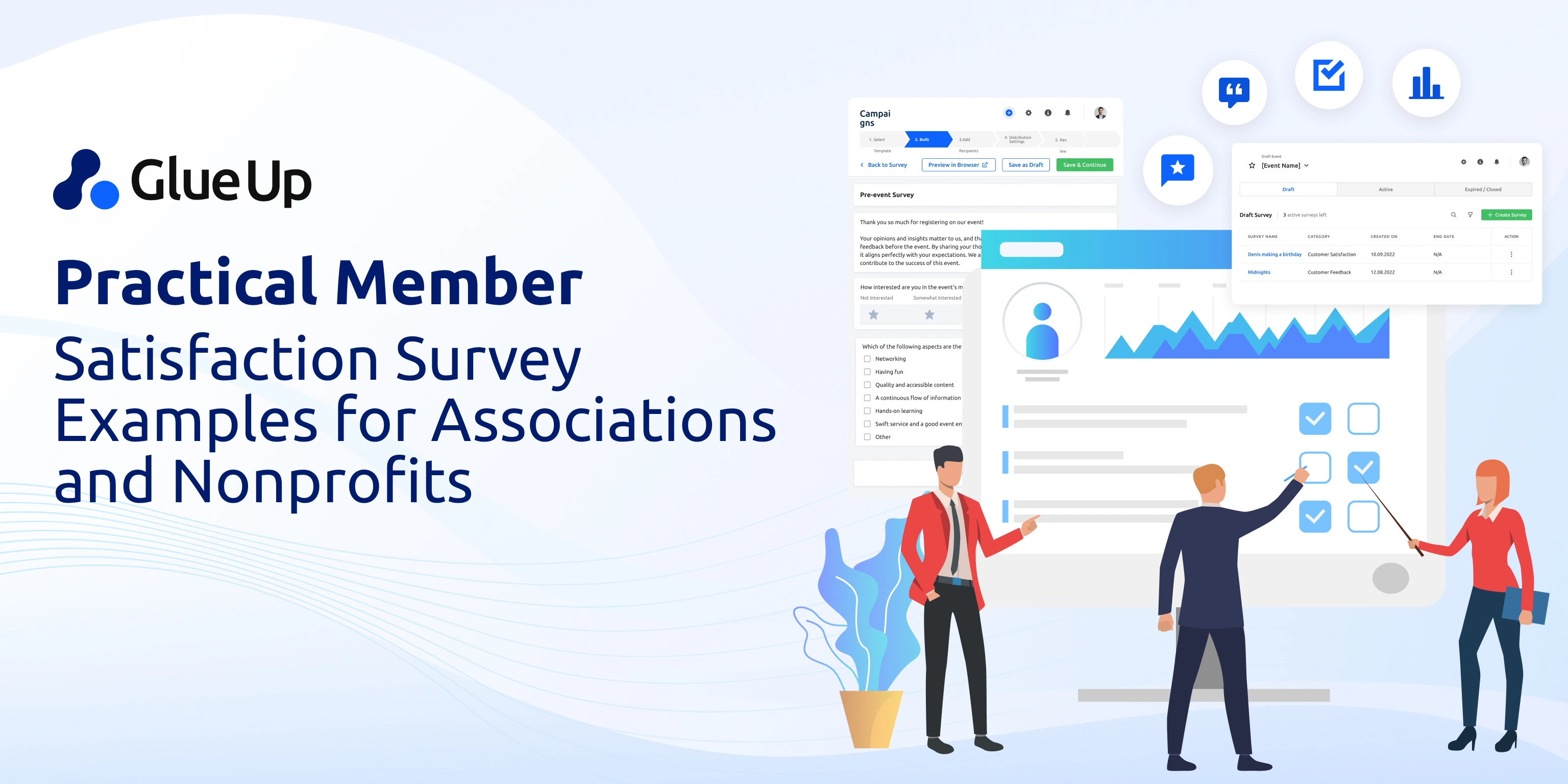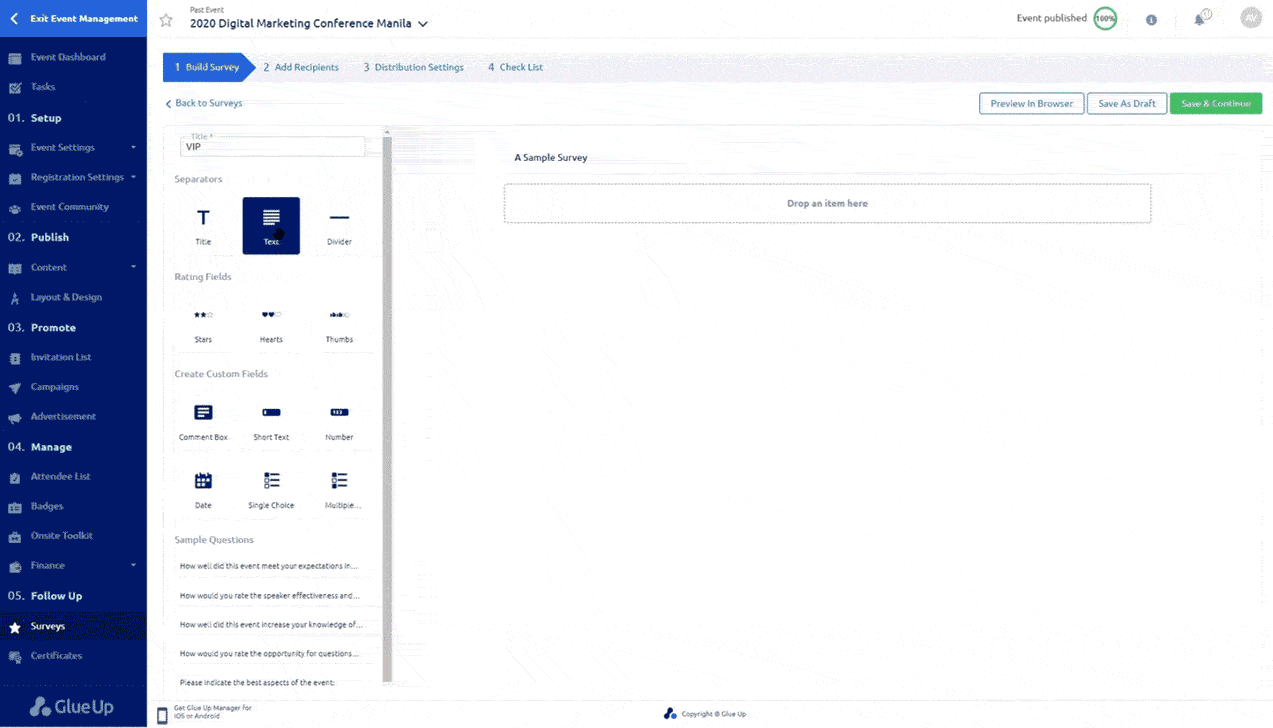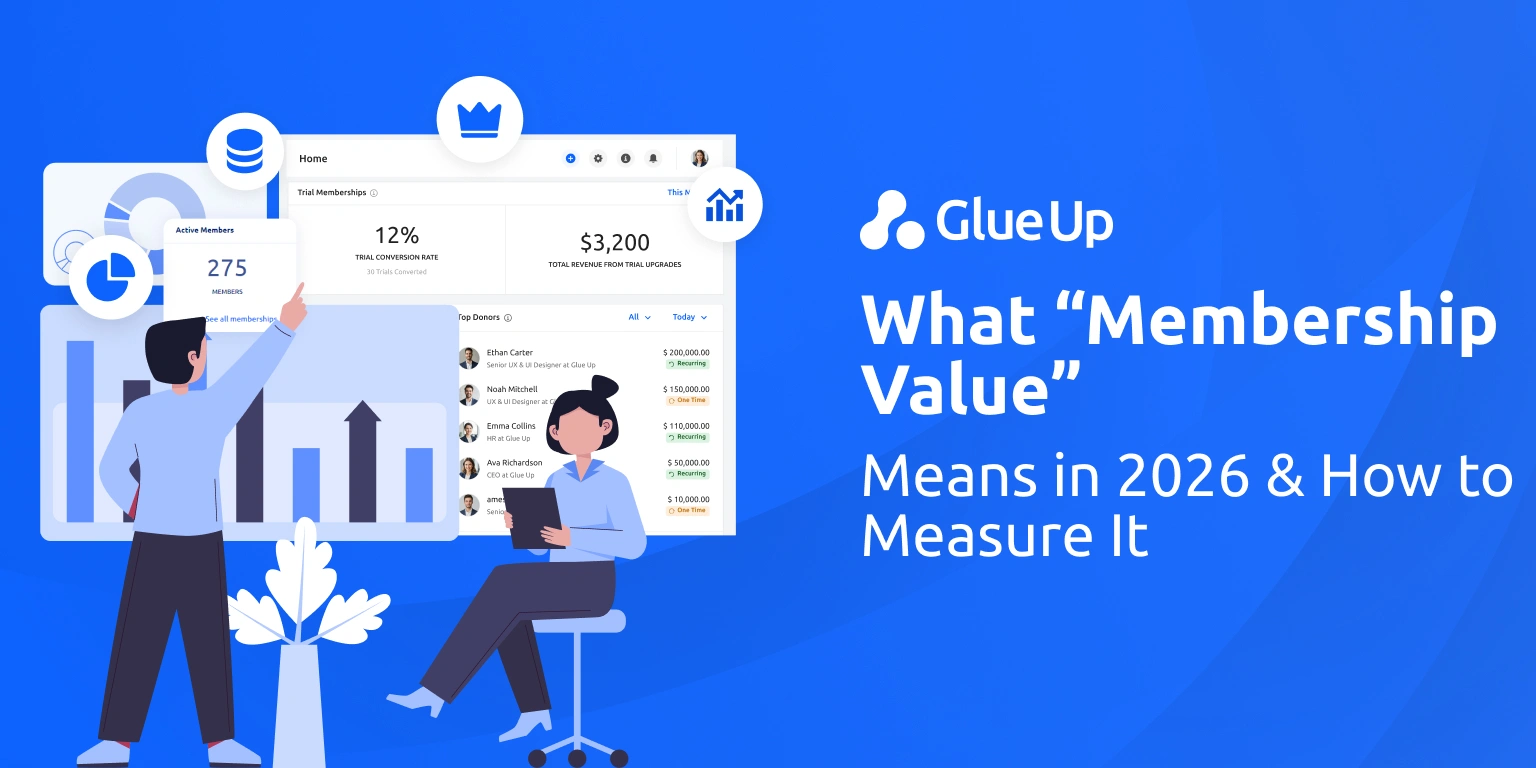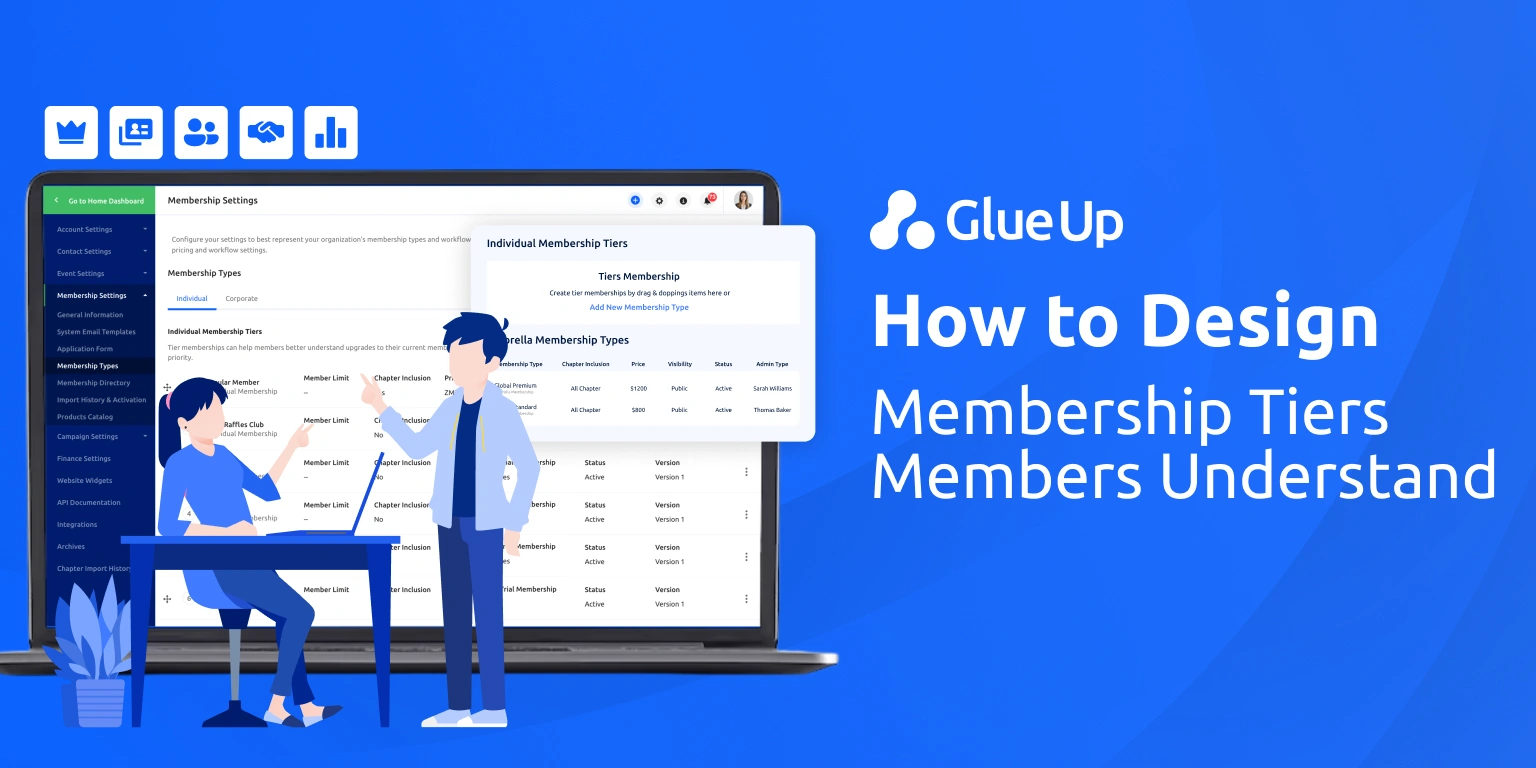
Every association and chamber eventually asks the same question: Are our members satisfied enough to stay, renew, and advocate for us? You can’t rely on assumptions. The only way to get clarity is by asking directly through a member satisfaction survey. Done well, these surveys uncover whether your programs, events, and benefits align with what members value most. Done poorly, they produce generic data that does little to inform leadership decisions.
In this post, we’ll look at practical survey examples that associations and chambers can use, and show how Glue Up’s survey software helps you gather feedback, analyze results, and act confidently.
Go Beyond Events with Member Surveys, Quizzes, and Polls
Glue Up’s event management software gives you everything you need to plan and easily deliver programs. Create branded registration pages, manage ticketing and payments, send automated reminders, and give members mobile access for a smooth experience.
Alongside these tools, you also have the option to run surveys, quizzes, and polls that help you capture feedback at different stages of the member journey.
To skip the read and see how this works in practice, book a demo today and explore how Glue Up brings events and feedback together in one platform.
Key Takeaways
- Member satisfaction surveys give associations actionable data for renewals, programming, and sponsor ROI.
- Annual surveys should be paired with quick polls or pulse checks to capture changing sentiment.
- Avoid pitfalls like asking generic questions, failing to segment, or ignoring feedback loops.
- Glue Up integrates surveys with membership, events, and community tools, making feedback part of your overall growth strategy.
- Feedback becomes most valuable when tied directly to action—informing decisions across the association.
What Is a Member Satisfaction Survey?
As a consumer, professional, or association leader, you already know what a survey is. However, a member satisfaction survey is slightly different from conventional ones. It’s a structured tool built to plan, execute, and measure your programs, benefits, and engagement efforts and align them with what members expect.
Why It Matters for Retention
Retention is the clearest measure of member value. Organizations that regularly conduct satisfaction surveys report renewal rates 8 to 10% points higher than those that don’t, according to SurveyMonkey. Survey data helps you flag at-risk cohorts before they churn and intervene with targeted outreach that protects recurring revenue.
Why It Matters for Program Development
Surveys tell whether members value your events, education, or advocacy work. Instead of relying on generic input from a handful of board members, you can quantify demand and reallocate resources to the initiatives with the strongest satisfaction scores. That means fewer wasted hours and budgets toward programs that drive measurable engagement.
Why It Matters for Sponsorship and Partnerships
Sponsors don’t just want logo placement. They want proof that members are paying attention. Member satisfaction data segmented by role, seniority, or chapter gives you hard evidence. For example, showing that 78% of senior executives rate your webinars as “very satisfied” strengthens your case when negotiating multi-year sponsorships. To support this claim, research from PwC highlights that credibility with executives increases significantly when data is presented at this level of granularity.
Why It Matters for Strategic Planning
High-performing associations use satisfaction surveys as an input into their annual planning cycle. The data becomes a baseline for the board, benchmarked year over year, and tied directly to KPIs such as net promoter score (NPS), engagement indexes, and renewal forecasts. Without this evidence, strategic planning risks being reactive instead of grounded in member intelligence.
Types of Membership Surveys
Understanding the value of member satisfaction surveys is only the starting point. To translate insights into strategy, associations need to deploy the right survey for the right situation. Not every instrument serves the same purpose. Below are the most effective types of membership surveys and how they can guide decision-making:
Annual Satisfaction Surveys
This is the benchmark tool most boards expect. Conducted once a year, it measures how satisfied members are with the organization overall. The findings provide year-over-year data that inform renewal forecasts, advocacy priorities, and programming budgets. When designed well, this survey gives executives the confidence to tie satisfaction metrics directly to KPIs such as retention or event participation.
Event or Program Surveys
These capture real-time feedback tied to specific experiences. Whether it’s a webinar, conference, or training series, event surveys show what resonated and what fell short. The key is timing: distribute the survey immediately after the event while engagement is still high. The data can shape your content strategy and justify program adjustments before the next event cycle.
Renewal Intent Surveys
Predicting churn is easier when you ask about it directly. Renewal intent surveys focus on members approaching the end of their term. By probing for satisfaction levels, likelihood to renew, and perceived value, you can spot at-risk segments before they lapse. Associations that incorporate renewal intent surveys into their workflow reduce avoidable attrition and reallocate staff time toward proactive retention efforts.
New Member Onboarding Surveys
The first ninety days of membership often define long-term satisfaction. Onboarding surveys assess whether new members understand the benefits available to them, feel welcomed, and see immediate value. Insights from this survey can guide adjustments in onboarding communications, chapter engagement, or mentorship initiatives. Strong onboarding feedback is often correlated with higher renewal rates at the one-year mark.
Quick Pulse Polls
Sometimes, leadership doesn’t need a 30-question survey to make decisions. Pulse polls or short surveys with one to three targeted questions help gauge sentiment on emerging issues. For example, before launching a new certification program, you might poll members to see how many would register. Pulse polls ensure agility, allowing associations to test ideas without over-surveying members.
Common Pitfalls in Member Surveys
Even well-intentioned surveys can fail if they aren’t designed or executed correctly. Associations often fall into predictable traps that produce shallow data or disengage members. Recognizing these pitfalls is the first step toward avoiding them.
Asking Too Many Generic Questions
Long surveys filled with vague questions dilute response quality. Members don’t want to spend 20 minutes answering items that don’t feel relevant. The result is low completion rates and generic feedback that leadership can’t use. A five-minute survey with focused, actionable questions is far more effective.
Failing to Segment Responses
Averages often hide the truth. For example, an overall satisfaction score of 70% may look acceptable, but without segmenting by membership tier or chapter, you might miss that senior executives are highly dissatisfied while younger professionals are not. Lack of segmentation means leaders make decisions on incomplete data, which can worsen retention issues.
Poor Timing and Survey Fatigue
Sending a survey right after another, or at the wrong point in the member lifecycle, erodes trust. Members start ignoring requests for feedback altogether. Timing matters: renewal intent surveys work best 90 days before expiration, while onboarding surveys should hit within the first 30 days. Poor timing means valuable feedback goes unheard.
Ignoring Feedback After Collection
Nothing erodes credibility faster than asking for input and then doing nothing with it. If members don’t see changes or communications based on their responses, they conclude surveys are a box-checking exercise. Associations that close the loop by publishing key findings and planned actions see higher participation and more candid feedback in future surveys.
Treating Surveys as a One-Off Exercise
Surveys are often run in isolation, disconnected from a larger strategy. Without integration into dashboards, KPIs, or board reporting, they lose impact. A member satisfaction survey only creates value if it becomes part of a continuous measurement system. Otherwise, leadership decisions risk being reactive rather than data-informed.
Practical Member Satisfaction Survey Examples
Designing a strong member satisfaction survey isn’t about quantity; it’s about asking the right questions at the right time. Below are five templates associations can copy, adapt, and deploy immediately. Each is tied to a specific use case and explains the value behind the questions.
Annual Satisfaction Survey
This is your strategic benchmark. It measures overall satisfaction and identifies trends you can present to the board. Use it once per year to align programming with member needs.
Template
- How satisfied are you with your overall membership experience? (1–5 scale)
- Which of our programs or services have provided you with the most value in the past year?
- Are there benefits you feel are underutilized or unclear?
- How likely are you to recommend this association to a peer or colleague? (Net Promoter Score)
- What one improvement would make your membership more valuable in the coming year?
Renewal Intent Survey
Send this 90 days before membership expiration. The goal is to identify at-risk members and intervene before they lapse.
Template
- How likely are you to renew your membership? (1–5 scale)
- What are the main factors influencing your decision to renew or not renew?
- Have you received enough value from your membership to justify the cost?
- Which benefits would make renewal more compelling for you?
- Is there anything that would cause you to end your membership?
New Member Onboarding Survey
Run this within the first 30–60 days of joining. It tests whether your onboarding process is clear, engaging, and sets the stage for long-term retention.
Template
- How easy was it to understand your membership benefits after joining? (1–5 scale)
- Did you feel welcomed and supported during your first month?
- Which resources (guides, orientations, mentors) were most helpful to you?
- What additional support would have made your onboarding experience stronger?
- How likely are you to recommend joining to a colleague?
Pre-Event Survey
Send this before a major webinar, conference, or training. It helps you align event content with member expectations.
Template
- Which session topics are most relevant to you? (list of options)
- What outcomes are you hoping to achieve by attending this event?
- Are there specific challenges in your role that you’d like addressed during the program?
- How did you hear about this event? (email, community, referral, other)
- What would make this event a worthwhile investment of your time?
Post-Event Survey
Send this immediately after an event while the experience is fresh. It ensures continuous improvement and documents sponsor ROI.
Template
- How satisfied were you with the overall event experience? (1–5 scale)
- Which sessions or activities delivered the most value?
- Did the event meet your expectations in terms of networking and learning opportunities?
- How would you rate the event’s organization and logistics?
- Would you attend a similar event in the future? Why or why not?
Close the Feedback Loop with Glue Up’s Survey Software

Collecting feedback is only useful if you can turn it into action. That’s why Glue Up makes surveys a built-in feature of the broader platform rather than a standalone tool. Our survey builder lets you design, distribute, and analyze responses without leaving the system where you already manage members, events, and communities.
- Integrated with Membership Records: Segment responses by tier, chapter, or demographics so you see which groups are thriving and which need attention.
- Event-Linked Surveys: Attach surveys directly to event pages or automate pre- and post-event questionnaires to capture insights when engagement is highest.
- Community Engagement: Post surveys, quizzes, or polls in the member community to spark conversation and collect fast feedback.
- Actionable Dashboards: View results alongside engagement metrics to connect satisfaction data with real business outcomes.
Glue Up gives associations and chambers a single system where feedback isn’t siloed. It flows directly into the tools you use to improve programming, renewals, and events.
Book a demo today to see how surveys work seamlessly with the rest of your membership management software.
Frequently Asked Questions
How often should associations run member satisfaction surveys?
At least once a year, with shorter pulse surveys or polls quarterly to capture evolving needs.
What’s the best way to improve survey response rates?
Keep surveys concise, explain why feedback matters, and share how results will be used. Offering small incentives can also increase participation.
Can surveys predict renewal behavior?
Yes. Renewal-intent questions and satisfaction benchmarks are strong indicators of whether a member will stay or lapse.
How does Glue Up help with surveys?
Glue Up provides built-in survey tools that connect responses with membership records, event data, and community activity, giving you context-rich insights.
Quick Reads
- Add-On Cart for Member Retention & Growth
- Simplify Multi-Currency Payment Posting for Community Chapters With Glue Up + Paygage
- AI Automation for Event Registration & Beyond
- Integrating AI into CRM for Membership Growth
- How to Build a Chapter Event Calendar
- What Is All-In-One Association Software?
- AI-Powered Member Check-In Software



